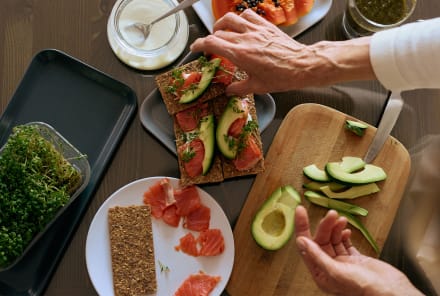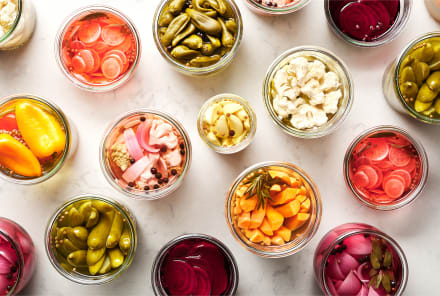Advertisement
The 10 Best Types Of Protein For Hormone Balance


When it comes to hormonal balance, certain protein sources serve you better than others. Eating protein provides your body with amino acids that are used to produce specific hormones, like estrogen, insulin, and thyroid hormone (to name a few).
Protein is personal. Certain protein sources (e.g., grain-fed beef, grains, legumes) can overstimulate the immune system and create inflammation in some people.
Protein can also impact your gut, shifting the microbiome1 diversity and balance. Although still being understood through research, the gut microbiota can in turn impact hormone levels, particularly estrogen2.
While we do not yet understand the effect of all forms of protein on different hormones, let’s explore what we do know about the impact of certain protein sources on three key hormones: estrogen, thyroid, and insulin.
Estrogen effects of protein.
Estrogen is the hormone primarily responsible for making us uniquely women, with breasts, hips, curves, and glossy locks; that is, we’re not simply small men. Women’s hormonal milieu and even responses to nutritional factors are unique, and protein is no exception.
As a doctor, I’ve observed an unusual phenomenon. When women eat grain-fed, hormone-injected, superbug-infected meat, it can negatively impact digestion and may cause bloating or constipation. And this effect on the gut leads to hormonal imbalance, raising estrogen levels3.
Here is the underlying biology: While it’s true that meat has a higher fat content than other sources of protein (legumes, grains, nuts), the bigger problem is what can be hidden in the fat of meats you find at your grocery store.
You are anciently hard-wired4 by your own DNA and microbiome to eat mostly vegetables, nuts, seeds, the occasional fruit, and clean proteins. In fact, such native and unprocessed foods keep you lean, metabolically healthy5, and balanced when it comes to hormones, particularly estrogen.
When you eat conventionally raised red meat, estrogen overload6 is more likely. When you go meatless or even semi-vegetarian, your estrogen levels are lower7. So, vegetarians have the edge here. This meat/estrogen relationship could be due to the hormones in the meat, the type of bacteria cultivated in the guts1 of people who eat a lot of meat, or a combination of factors.
We do know that a meat-heavy diet is linked to higher body mass index8 (and also more abdominal obesity). Red and processed meat intake specifically ups risk for obesity9 and a larger waist circumference.
We also know that a dietary pattern with too much of the wrong type of fats (saturated instead of unsaturated) raises estrogen and increases risk for serious conditions10 like breast cancer and heart disease. Obesity is also known to elevate estrogen levels and risk for cardiovascular disease11 and breast cancer12.
Omnivorous women with estrogen excess don’t remove that excess in their bowel movements like women who eat a more plant-based diet—which contains more fiber and facilitates removal of excess estrogen13.
Vegetarians poop more volume and excrete three times the amount of estrogen13 as meat eaters, thereby preventing estrogen overload. In fact, estrogen levels13 in the blood of vegetarians are 15 to 20 percent lower than those of omnivores. Because of the critical role of fiber in estrogen balance, it’s no wonder that a clear, inverse relationship exists between fiber and breast cancer risk14.
Although not related to protein, another modifiable lifestyle factor that raises estrogen levels (and increases breast cancer risk) is alcohol intake15. So some of the best ways to support healthy estrogen levels are in our control. Limit alcohol and meat (red meat especially; instead, focus on quality, lean protein) and eat more sources of fiber (25 to 40 grams per day), especially vegetables.
Thyroid effects of protein.
The first major culprit for thyroid dysfunction are protein sources that contain gluten. Through the gut-thyroid axis, gluten can contribute to autoimmune thyroiditis, the leading cause of hypothyroidism. In fact, patients with celiac disease have a higher prevalence of autoimmune thyroiditis16, and a gluten-free diet has been shown to reduce the thyroid antibody load in women with Hashimoto’s17 (autoimmune hypothyroidism).
Another protein-centric culprit is fish high in mercury. Mercury is an endocrine disrupter 18to both thyroid and estrogen homeostasis. The worst mercury offenders19 are tuna (especially ahi and bigeye), shark, swordfish, king mackerel, marlin, orange roughy, and tilefish.
In the thyroid, mercury and iodine are biochemically similar, so your thyroid may absorb and store mercury at the expense of iodine. Women with mercury toxicity are twice as likely to test positive for thyroid antibodies. Mercury unfortunately also acts like a xenoestrogen (mimics estrogen) by binding to and activating your estrogen receptors20.
Safe sources of marine protein19 include Alaskan salmon, cod, snapper, tilapia, trout, sardines, anchovies, herring, flounder, catfish, haddock, sturgeon, clams, crab, oysters, lobster, shrimp, and scallops (to name a few).
Insulin effects of protein.
Eating sufficient fiber (a common nutrient gap) throughout our lives is an important part of stabilizing blood sugar, preventing insulin resistance, and reducing risk of type 2 diabetes21. Meat eaters consume significantly less fiber22 than vegetarians and vegans.
In other words, a plant-based diet may provide a distinct fiber advantage when it comes to glucose and insulin homeostasis, although the jury is out on whether people who eat anti-inflammatory protein sources from animals with adequate fiber intake from fruits, vegetables, legumes, etc. fare as well.
Women who eat red meat may have higher rates of blood sugar problems, as indicated in an important, large-scale prospective study23 published in the prestigious Journal of the American Medical Association. The red meat consumption was assessed for nearly 150,000 people, and an increased risk for type 2 diabetes was observed for higher red meat intake. While not a causal finding, this rigorous observational link is important nonetheless.
So what’s a good dietary pattern to follow when it comes to insulin? A Paleo-based food plan24 helps improve blood sugar levels in the short term, at least compared with the outdated low-fat American Diabetes Association (ADA) diet. The much more sustainable Mediterranean diet (low in meat in general, but does feature seafood and other lean proteins) has a wealth of research supporting its role in preventing and mitigating type 2 diabetes25.
Although more research is needed, the ketogenic diet has been shown to improve insulin sensitivity28, and there is a growing body of evidence supporting its utility for managing obesity and type 2 diabetes29. Whether these keto benefits are gender-equal (in my medical experience, keto may be more effective in men than women) is yet to be determined.
When it comes to environmental toxins from protein, mercury is important to consider for insulin effects too. According to a systematic review of observational studies, higher exposure to this heavy metal is associated with a greater risk of diabetes and metabolic syndrome30.
Now that we’ve explored the physiological underpinnings of protein effects on the balance of three key hormones (estrogen, thyroid, and insulin), I wanted to share my ten favorite protein sources. Check out these healthy vegan and omnivorous options for high-quality protein.
My top 5 vegan protein picks:
1. Pea protein:
I’m a big fan of pea protein because it’s a complete protein, i.e., it provides all of the essential amino acids, although it’s relatively low in methionine, so consider complementing with a methionine-rich vegan food like brown rice. In terms of body composition effects, pea protein has been shown to be as effective as whey protein when it comes to muscle strength and performance31.
Pea is also one of the least allergenic forms of protein, so you are unlikely to develop intolerance as you might with other proteins that contain ingredients with allergenic potential (e.g., gluten and dairy). Choose a powder form of pea protein that’s free of gluten and dairy and low in sugar (less than 5 grams per serving).
2. Lentils and other legumes:
Some people tolerate legumes well; others experience inflammation, perhaps due to a personal sensitivity to lectins32 or due to the prebiotic fiber’s fermentation in the gut. See what’s true for you.
3. Seeds:
Especially flax, chia, and sunflower.
4. Hemp protein:
Hemp delivers all nine essential amino acids (although lysine is low), and it is one of the most digestible forms33 of plant protein if you have gut issues.
5. Nuts:
Macadamia nuts, Brazil nuts, and walnuts are my favorites since they are less dense in carbs34 but a great source of protein, fiber, healthy fats, vitamins, and minerals.
Avoid: gluten (wheat, rye, barley), and if grains as a broad category are inflammatory for you personally, then avoid grains.
My top 5 omnivore protein picks:
1. Wild-caught fish:
Salmon, anchovies, sardines, herring, and mackerel are top-notch protein sources and loaded with healthy omega-3 fats.
2. Crustaceans:
Particularly oysters, which are rich in essential minerals35, particularly copper, iron, and zinc.
3. Red meat:
Consume in moderation, not regularly. Go for wild or grass-fed and grass-finished whenever possible.
4. Poultry and eggs:
Go with pastured poultry and eggs.
5. Vegan sources (see above):
Be a flexitarian and incorporate vegan protein sources in your diet too. Keep in mind that rotation of different foods can help prevent intolerance over time.
Avoid: processed and cured meats, grain-fed meat or poultry, dairy (if intolerant), mercury-heavy fish such as tuna (ahi, bigeye), swordfish, shark, king mackerel, marlin, orange roughy, and tilefish.
What's the right dose of protein?
Before we wrap up, let’s talk about how much protein is needed. Well, that depends since we’re unique individuals with personalized nutrition needs.
Healthy individuals need at least 0.8 grams of protein per kilogram of body weight per the National Academy of Medicine’s (NAM) Dietary Reference Intake. This NAM level is considered to be a minimum level36 for preventing muscle loss. For long-term muscle, metabolic, and overall health, 1 to 1.6 grams of protein per kilogram of body weight is a smarter daily goal to aim for.
For example, a 150-pound woman would need to consume about 70 to 110 grams of protein per day. That’s approximately 25 to 35 grams of protein in each meal, if you eat three meals per day. For a woman who’s regularly engaging in physical activity, aim for the higher end of this range.
Your protein needs will be even higher if you are an endurance athlete or are dealing with a major illness or infection (check with your doctor if that’s the case). When it comes to protein consumption, you want to determine the correct dose, personalized to your current life stage and needs. Too little protein will mean you lose lean body mass, and in people who’ve lost weight, adequate protein is a critical piece of the puzzle for long-term maintenance of that weight loss success.
When you eat excess protein (especially in a no-carb or low-carb diet), it may be converted into sugar, raising blood sugar, through a process called gluconeogenesis37. So calculate your protein needs (a range is fine), choose the high-quality protein sources for you and your lifestyle, and then track your weight, blood sugar, and body composition over time.

Sara Gottfried, M.D. is three-time New York Times bestselling author of The Hormone Cure, The Hormone Reset Diet, and her newest book, Younger. After graduating from Harvard Medical School and MIT, Dr. Gottfried completed her residency at the University of California at San Francisco. She is a board-certified gynecologist who teaches natural hormone balancing in her novel online programs so that women can lose weight, detoxify, and slow down aging. Dr. Gottfried lives in Berkeley, CA with her husband and two daughters. Learn more at SaraGottfriedMD.com.
More from the author:
How To Balance Your Hormones
Check out Correct Hormone Imbalance For Better Skin, Improved Digestion & Less Fatigue
More from the author:
How To Balance Your Hormones
Check out Correct Hormone Imbalance For Better Skin, Improved Digestion & Less Fatigue

Sara Gottfried, M.D. is three-time New York Times bestselling author of The Hormone Cure, The Hormone Reset Diet, and her newest book, Younger. After graduating from Harvard Medical School and MIT, Dr. Gottfried completed her residency at the University of California at San Francisco. She is a board-certified gynecologist who teaches natural hormone balancing in her novel online programs so that women can lose weight, detoxify, and slow down aging. Dr. Gottfried lives in Berkeley, CA with her husband and two daughters. Learn more at SaraGottfriedMD.com.
37 Sources
- https://www.ncbi.nlm.nih.gov/pmc/articles/PMC5385025/
- https://www.ncbi.nlm.nih.gov/pmc/articles/PMC6952974/
- https://www.ncbi.nlm.nih.gov/pmc/articles/PMC3574573/
- https://www.ncbi.nlm.nih.gov/books/NBK482457/
- https://www.ncbi.nlm.nih.gov/pmc/articles/PMC4163920/
- https://pubmed.ncbi.nlm.nih.gov/27440539/
- https://pubmed.ncbi.nlm.nih.gov/24050121/
- https://www.ncbi.nlm.nih.gov/pmc/articles/PMC2697260/
- https://pubmed.ncbi.nlm.nih.gov/24815945/
- https://www.ncbi.nlm.nih.gov/pmc/articles/PMC3915474/
- https://www.ncbi.nlm.nih.gov/pmc/articles/PMC6712750/#:~:text=It%20is%20well%20known%20that,children%20%5B23%2C%2024%5D.
- https://www.ncbi.nlm.nih.gov/pmc/articles/PMC2689796/
- https://pubmed.ncbi.nlm.nih.gov/3628202/
- https://www.sciencedirect.com/science/article/pii/S0923753419387320#bb0045
- https://www.ncbi.nlm.nih.gov/pmc/articles/PMC4531831/
- https://www.ncbi.nlm.nih.gov/pmc/articles/PMC5435852/
- https://pubmed.ncbi.nlm.nih.gov/30060266/
- https://pubmed.ncbi.nlm.nih.gov/19280433/
- https://www.fda.gov/food/consumers/advice-about-eating-fish
- https://pubmed.ncbi.nlm.nih.gov/17588195/
- https://pubmed.ncbi.nlm.nih.gov/29628808/
- https://www.ncbi.nlm.nih.gov/pmc/articles/PMC3967195/
- https://www.ncbi.nlm.nih.gov/pmc/articles/PMC3847817/
- https://www.ncbi.nlm.nih.gov/pubmed/25828624
- https://pubmed.ncbi.nlm.nih.gov/32726990/
- https://www.ncbi.nlm.nih.gov/pmc/articles/PMC6361831/
- https://www.ncbi.nlm.nih.gov/pmc/articles/PMC6720297/
- https://www.ncbi.nlm.nih.gov/pmc/articles/PMC6472268/
- https://pubmed.ncbi.nlm.nih.gov/30289048/
- https://pubmed.ncbi.nlm.nih.gov/28482296/
- https://www.ncbi.nlm.nih.gov/pmc/articles/PMC6358922/
- https://www.ncbi.nlm.nih.gov/pmc/articles/PMC6603809/
- https://pubmed.ncbi.nlm.nih.gov/20977230/
- https://www.ncbi.nlm.nih.gov/pmc/articles/PMC5707743/
- https://fdc.nal.usda.gov/fdc-app.html#/food-details/174219/nutrients
- https://www.ncbi.nlm.nih.gov/pmc/articles/PMC6566799/
- https://academic.oup.com/ajcn/article/90/3/519/4597025
Watch Next
Enjoy some of our favorite clips from classes
Enjoy some of our favorite clips from classes
What Is Meditation?
Mindfulness/Spirituality | Light Watkins
Box Breathing
Mindfulness/Spirituality | Gwen Dittmar
What Breathwork Can Address
Mindfulness/Spirituality | Gwen Dittmar
The 8 Limbs of Yoga - What is Asana?
Yoga | Caley Alyssa
Two Standing Postures to Open Up Tight Hips
Yoga | Caley Alyssa
How Plants Can Optimize Athletic Performance
Nutrition | Rich Roll
What to Eat Before a Workout
Nutrition | Rich Roll
How Ayurveda Helps Us Navigate Modern Life
Nutrition | Sahara Rose
Messages About Love & Relationships
Love & Relationships | Esther Perel
Love Languages
Love & Relationships | Esther Perel

















